International links in CCFS
BACKGROUND
International links in CCFS provide leverage of intellectual and financial resources on a global scale, and an international network for postgraduate experience. International Partners provide the core of such collaboration. Other international activity includes funded projects and substantial collaborative programs with exchange visiting programs in France, Norway, Germany, United Kingdom, New Zealand, Canada, USA, Taiwan, Italy, Spain, South Africa, South America, China, Brazil, Japan, Thailand and Russia.
FUNDED COLLABORATIVE PROJECTS COMMENCED OR ONGOING IN 2011 INCLUDE: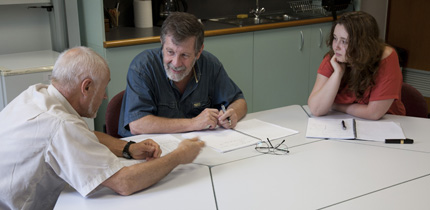
Zdislav Spetsius, Bill Griffin and Ekaterina Rubanova discussing Ekaterina’s PhD project.
Macquarie
- A formal MOU was signed with the China University of Geosciences (CUG), Wuhan, to promote collaborative research and exchange of postgraduate students. Professors Sue O’Reilly and Bill Griffin were invested as Guest Professors at CUG (Wuhan) and participated in a 2-day postgraduate seminar workshop. Formal visits of high-level University delegates took place between Wuhan and Macquarie University. The first cotutelle student (Mr Qing Xiang) commenced at GEMOC/CCFS in October 2011, and Dr Chunmei Yu undertook research during a 6-month stay at Macquarie. Ongoing research continued in collaboration with Professor Jianping Zheng and his group, and with seismologist Professor Yinhe Luo (e.g. see CCFS Publications #18, 44, 95, 97). Areas of geochemical research include the evolution of the lithosphere beneath several parts of China, crustal evolution in the North China Block, the Yangtze Block and southeastern China, the UHP metamorphism of Dabie-Sulu peridotites and ultramafic rocks and ophiolites in Tibet. Geophysical research includes shallow and deep seismology in western and southeastern China and Tibet.
- Following the signing of a formal MOU in 2011 with the China Academy of Science, (Beijing) involving the Institutes of Geology and Geophysics, collaboration expanded in 2011 with exchange of personnel, a new cotutelle PhD project (Ms Yuya Gao), and joint access to the complementary analytical equipment at each institution. In the first exchange, Dr Chuanzhou Liu completed a 6-month stay at GEMOC aimed at transfer of GEMOC’s technology for in situ analysis of Os isotopes. Collaboration on technology development remains a focus, capitalising on complementary strengths at each institution.
- race elements and fluids in diamonds and relevance to mantle fluids and processes; with Professor Oded Navon (Hebrew University, Israel), Professor Thomas Stachel (Edmonton, Canada) and Dr Jeff Harris (University of Glasgow, UK). This was originally funded by an ARC Discovery Project, which was relinquished, with the funding now provided from a CCFS allocation. This includes the PhD project of Ms Ekaterina Rubanova. Dr Zdislav Spetsius (Mirny, Siberia) visited GEMOC as an external advisor to this PhD, and for analytical work connected with the diamond project, on which Dan Howell is the postdoctoral Research Fellow.
- Detailed 2-D and 3-D structure of the Kaapvaal Craton in several time slices, using mantle-derived xenocrysts; a collaborative project with De Beers.
- Global Lithosphere Architecture Mapping, involving analysis of crustal evolution, the composition of the lithospheric mantle and the interpretation of seismic tomography; a collaborative project with Minerals Targeting International, BHP Billiton and Professor Steve Grand (University of Texas at Austin).
- Collaboration continued with Professor Massimo Coltorti and Dr Costanza Bonadiman from the University of Ferrara on the geochemistry of amphiboles, mantle metasomatism, and the age and origin of the lithospheric mantle beneath the Cape Verde Islands and Antarctica.
Discussions at Montpellier for FAST DIISR project (Norman Pearson, Jennifer Chauffaud, Sue O’Reilly and Sylvie Demouchy.
- A TerraneChron® study to unravel the timing and tectonic history of regions in Tibet continued as a collaborative program with the National University of Taiwan (led by Professor Sun-Lin Chung), and has expanded to include collaboration with Nanjing University and the Institute for Tibetan Plateau Research, Beijing.
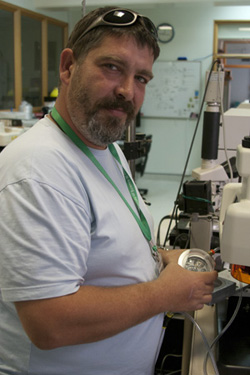
- The nature of the lithosphere in Mongolia, Vietnam and Russia, with Dr Kuo-Lung Wang (Institute of Earth Sciences, Academia Sinica, Taiwan).
- Development of methodology for lithium-isotope signatures in ultramafic and mafic rocks continued with Dr Mei-Fei Chu (National University of Taiwan).
Olivier Alard, CI on FAST DIISR MQ-Montpellier project.
- Collaboration with colleagues at the University of Jean Monnet, St Etienne, including Professor Jean-Yves Cottin, Dr Bertrand Moine and Dr Marie-Christine Gerbe (with reciprocal funding from both sides) expanded. A formal agreement between the two universities includes PhD exchange, academic exchange and research collaboration relevant to the nature of the lithosphere in the Kerguelen Archipelago, Crozet Islands and the Hoggar region of Algeria.
- Collaboration with colleagues at the University of Montpellier continued with the cotutelle PhD project of Yoann Gréau (graduated 2011) and projects on the mantle budget of platinum group elements, microstructures of meteorites and mantle rocks, and ophiolites. A collaboration funded by the DIISR Grant “Probing the composition of the early Solar System and planetary evolution processes” continued. Exchange visits of Dr Olivier Alard and two postgraduate students from Montpellier (Jennifer Chaufard and Valerie Migeon) to CCFS/GEMOC in January 2011, Drs Olivier Alard and Sylvie Demouchy, and Professors O’Reilly and Griffin and Associate Professor Norman Pearson to Montpellier, advanced the research on this project.
- Igneous rocks, mineral deposits, lithosphere structure and tectonic setting: southeastern China and eastern Australia. This collaboration with Nanjing University has expanded from an AusAID grant under the ACILP scheme with Professor Xisheng Xu (Nanjing University). Cotutelle PhD student Yao Yu from Nanjing undertook research at CCFS/GEMOC, to carry out further FTIR studies of water in mantle-derived xenoliths.
- Several collaborative projects continued with Dr Kreshimir N. Malitch (Department of Geochemistry, All-Russia Geological Research Institute (VSEGEI), St Petersburg) including: (1) the nature and origin of zircons from the intra-continental paleorift-related ultramafic-mafic intrusions of the Noril’sk area (northern Siberia, Russia), including economic and subeconomic PGE (platinum-group element)-Cu-Ni sulfide deposits; (2) analysis of Os-(Ir-Ru) alloy grains in two world-class Au-PGE placer deposits associated with the Guli clinopyroxenite-dunite massif (northern Siberia, Russia) and the Evander Goldfield within the Witwatersrand Basin (South Africa). The main aim of this study is to place further constraints on osmium-isotope signatures of the mantle sources for Os-rich alloy grains at Guli and Evander, which (along with the Witwatersrand grains) represent the oldest terrestrial platinum-group minerals known so far.
- Collaboration with Professor Yuri Kostitsyn (Vernadsky Institute of Geochemistry and Analytical Chemistry (GEOKHI), Russian Academy of Science) includes studies on continental crust formation in a modern subduction zone on the Kamchatka Peninsula. Professor Kostitsyn is also involved with Dr Elena Belousova in the CCFS/GEMOC project testing models for continental crustal growth using the TerraneChron® database.
- A collaborative project with Alexander Kremenetsky, Director of the Institute of Mineralogy, Geochemistry and Crystal Chemistry of Rare Elements (IMGRE), Moscow, Russia, utilised the TerraneChron® approach to look at the sources of giant heavy-mineral placer deposits in Australia and Russia.
- Studies on Cathaysia’s place in Rodinia, the crustal evolution of southeast China, and the crustal evolution of the Yangtze Block with Professor Jinhai Yu and Ms Lijuan Wang (collaborative project with Nanjing University and cotutelle program); Lijuan’s PhD was accepted in 2011 and she will graduate in 2012.
- Studies continued with Dr Rendeng Shi (Institute of Tibetan Plateau Research, China Academy of Sciences, Beijing) on the age and origin of platinum group alloy phases in podiform chromitites in ophiolites from Tibet.
- TerraneChron® analysis of Proterozoic terrains in Africa, North America and Europe, with several mineral-exploration companies.
- On-going collaboration with BHP Billiton (Dr Kathy Ehrig) and University of Tasmania (Professor Vadim Kamenetsky) looking for the evidence of younger magmatic events
- (e.g. Grenville-age event) in the magmatic evolution of the Gawler Craton, with a particular focus on the region around the giant Olympic Dam deposit.
- GEMOC continued relationships with the newly established International Precambrian Research Centre of China (IPRCC), with Bill Griffin joining the Board. He also participated in an international field trip to the oldest rocks in southern Africa (the Barberton Greenstone Belt and surrounding areas of Swaziland, and the Limpopo Belt), led by Professor Alfred Kroener, and taught part of a Geochronology Workshop in Beijing, sponsored by the IPRCC.
- Formal visits to Chinese institutions strengthened or initiated collaborative research projects and agreements: Nanjing University; China Academy of Sciences, Geology and Geochemical Institutes; China University of Geosciences (Beijing, Wuhan) and Hong Kong University.
- A new collaborative research project was initiated with the Royal Holloway University of London, to look at the crustal evolution and geodynamic history of Southeast Asia. The preliminary results and new constraints on basement ages, granitic magmatism, and sediment provenance in the Malay Peninsula were presented at the European Geosciences Union General Assembly 2010, Vienna, Austria, 2–7 May, 2010 and accepted for publication in Gondwana Research. Another milestone was the submission of Inga Sevastjanova’s PhD thesis; other students will begin in 2011.
- A collaboration with Dr Nada Vaskovic, of Belgrade University, on the geochronology of the Balkan ophiolites of Serbia and related rocks continued.

José María González-Jiménez and Monica Escayola in the GAU, GEMOC.
- Collaboration started with Dr Monica Escayola on the Os-isotope compositions of sulfides and alloys from ultramafic complexes in the Yukon; this will continue with Dr Escayola’s 6-month visit (funding from an Australian Endeavour Award) to carry out similar studies on rocks from the Andes.
- Collaboration continued with Dr Carlos J. Garrido (University of Granada, Spain), Dr Isabel Fanlo (University of Zaragoza, Spain) and Dr Antoni Camprubí (National University of Mexico) on the origins of chromitite deposits in ophiolites, including Os-isotope analysis of Platinum Group Minerals.
- Collaboration continued with Dr Vlad Malkovets (Novosibirsk) on the origins and modification of the lithospheric mantle beneath cratonic areas, using the compositions (including Os-isotope compositions) of sulfide phases included in mantle-derived minerals.
- A cotutelle agreement was signed with EOTVOS University (Prague), based on our continuing collaboration with Professor Csaba Szabo, who is investigating sulfide phases in xenoliths from around the Pannonian Basin.
- Dr Juan Carlos Afonso collaborated with Professors Ivone Jimenez-Munt, M. Fernandez, J. Verges and D. Garcia-Castellanos from Institute of Earth Sciences ‘Jaume Almera’, CSIC, Barcelona, Spain on a project “Characterisation of the lithospheric mantle beneath the Alpine orogenic belt from numerical modeling: a comparison between Atlas, Tibet, and Zagros” funded by the National Research Council of Spain.
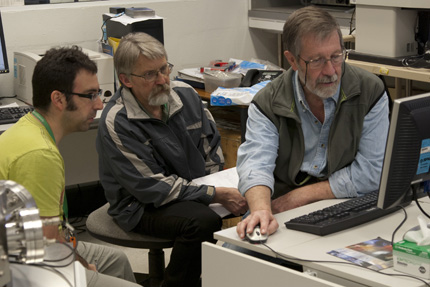
- Dr Craig O’Neill continued collaborations with Adrian Lenardic (Rice University) and Shijie Zhong (University of Colorado, Boulder) as part of the Flat Subduction Geodynamics CCFS project (Two-phase flow within Earth’s mantle: modeling, imaging and application to flat subduction settings).
José María González-Jiménez, Csaba Szabo and Bill Griffin at Macquarie.
- Professor Yinhe Luo from China University of Geosciences visited CCFS/GEMOC for three months to work with Dr Yingjie Yang on a project: “Imaging detailed crustal structures of the Dabie Orogenic Belt using ambient noise tomography.”
University of Western Australia
- Professor Cam McCuaig was invited by Professor Zeng-qian Hou, Director of the Institute of Geology, Chinese Academy of Geological Sciences (CAGS), to participate in the international project of IGCP/SIDA 600 “Metallogenesis of collisional orogens in the East Tethyside domain”. This project (2011-2014) is jointly funded by UNESCO and the Swedish International Development Cooperation Agency (SIDA) and lead by Professor Hou. The Centre for Exploration Targeting (CET), UWA was invited to be a partner institute and Professor Marco Fiorentini and Mr Yongjun Lu from CET are actively collaborating with CAGS under this IGCP framework. This collaboration between CET and CAGS will expand from studying potassic intrusions in the western Yangtze Craton to experimental and field studies of adakites and associated porphyry Cu systems in Tibet.
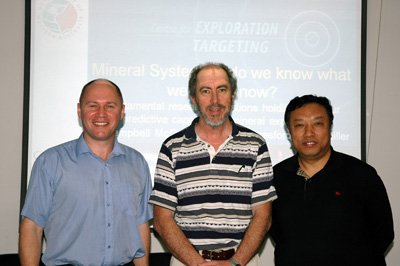
Cam and Peter with Professor Zeng-qian Houat CAGS (Chinese Academy of Geological Sciences). Professors McCuaig and Cawood were invited by Professor Zengqian Hou to CAGS, Beijing for collaboration.
- Researchers at UWA have an ongoing collaboration with Professor Robert Kerrich from University of Saskatchewan, Canada, which ranges from studying potassic intrusions in SW China and porphyry magmatism in the Philippines, to greenstone belts in the Yilgarn Craton and western Africa.
- Professor Cam McCuaig continued collaboration with Dr David Leach from the U.S. Geological Survey (USGS), leading to a paper “Banded Iron Formation to Iron Ore: Implications for the Evolution of Earth Environments”.
- A new collaborative project between Dr David Wacey and Martin Brasier (Oxford University, UK) commenced, investigating the geology and biodiversity of the 1900 Ma Gunflint Formation of Canada, in particular sulfur-based metabolisms.
- Dr David Wacey commenced a collaborative project with Nicola McLoughlin, Harald Furnes, Ingunn Thorseth from University of Bergen, Norway, investigating the emergence of life on Earth 3+ billion years ago funded by the Bergen Research Foundation and the University of Bergen.
- Professor Mark Barley continued his collaborations with international leaders in multiple sulfur isotope geochemistry (James Farquar, Boz Wing, Shuhei Ono, Doug Rumble, Sue Golding, Jay Kaufman etc.) to determine how the range of methods fits together.
- Dr Matt Kilburn continued a collaboration begun in 2009 with Bernard Wood and Jon Wade (University of Oxford, UK), to investigate the isotopic fractionation of elements between metal and silicate melts at high pressures and temperatures.
Curtin University
- Dr Xuan-Ce Wang is collaborating with Dr Jie Li (Guangzhou Institute of Geochemistry, Chinese Academy of Sciences, Guangzhou, China) on the petrogenesis of the Leiqiong flood basalts, with the aim of understanding the links between mantle plumes and subduction.
- Dr Sergei Pisarevsky is Paleomagnetic Coordinator on the International project “Reconstruction of supercontinents back to 2.7 Ga using the Large Igneous Province (LIP) record”, in collaboration with Dr Richard Ernst (Carleton University, Canada) and Dr Wouter Bleeker (Geol. Surv. of Canada). He also is Team Leader in the IGCP-SIDA Project 599 “The Changing Early Earth”, in collaboration with Dr Jaana Halla (University of Helsinki, Finland).
- Dr Zheng-Xiang Li has an ongoing collaborative project with a large group of researchers from around the world, including Dr D.A.D. Evans (Yale University), Dr S. Zhang (China University of Geosciences, Beijing) and the Nordic Paleomagnetic Working Group, aiming to establish the configuration and evolution of a pre-Rodinia supercontinent Nuna (Columbia) that probably existed between 1.8-1.4 Ga.
- Dr Zheng-Xiang’s work on the Phanerozoic magmatism and tectonics of South China is part of an ongoing collaborative project with Dr X.H. Li (Chinese Academy of Sciences (CAS), Beijing), Dr W.X. Li (CAS, Guangzhou), Professor X. Xu (Nanjing University), and Professor S.L. Chung and Dr Q.H. Lo (National Taiwan University).
- An ARC-CAS jointly-funded project on Mesozoic vertical tectonic movements in South China and subduction dynamics involves collaboration with Dr Y.G. Xu and and Dr W.X. Li (CAS-Guangzhou), and Dr M. Danisik (Univ of Waikato, NZ). A project on the tectonic evolution of Tibet and NW China is a collaboration with Dr Q. Wang (CAS–Guangzhou) and Dr C.L. Zhang (China Geological Survey–Nanjing). A newly funded NSF-China project to work on the development and evolution of the Red River Fault System involves a collaboration with Professor X.D. Jiang (China Ocean University).
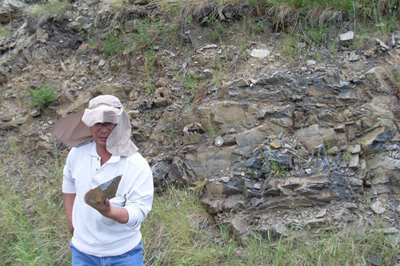
Jian-Bo Zhou of Jilin University examining a sample from the Mohe Complex of the Erguna Block, NE China, as part of a study of the Central Asian Orogenic Belt in China.
- Professor Simon Wilde continues to work with Professors Jian-Bo Zhou and Xing-Zhou Zhang of Jilin University on the evolution of the NE China segment of the Central Asian Orogenic Belt. Collaboration with Professor Xiao-Long Huang from the Guangzhou Institute of Geochemistry has led to the characterisation of the TTG gneisses in the Taihua complex at the extreme south of the North China Craton. Professor Xiao-Long Huang spent 12 months at Curtin working with Simon, supported by the Chinese Science Council and the Chinese Academy of Sciences.
- Simon’s ongoing collaboration with Dr Guochun Zhao of the University of Hong Kong has led to the recognition of two high-grade metamorphic events in rocks of the Huaian complex near the junction between two Proterozoic mobile belts: the Khondalite Belt and the Trans-North China Orogen. Collaborative work on the Central Indian Tectonic Zone with Professor Santanu Bhowmik of the Indian Institute of Technology at Kharagpur has focused on the application of U-Pb and Lu-Hf isotopic work on zircon and dating of monazite in high-grade metamorphic rocks.
- Simon’s long-standing collaboration with Professors Fuyuan Wu and Jinhui Yang at the Institute of Geology and Geophysics at the Chinese Academy of Sciences (CAS) in Beijing has led to compilation of an extensive geochronological data base for the Chinese part of the Central Asian Orogenic Belt and continued investigation of the isotopic signature of magma mixing in the North China Craton. Ongoing collaboration with Profs Dunyi Liu and Yusheng Wan and their students at the Institute of Geology at the Chinese Academy of Geological Sciences (CAGS) in Beijing has recently focused on examining events that straddle the Archean/Proterozoic boundary in the Western Block of the North China Craton. Collaboration with Dr Yuruo Shi of CAGS has concentrated on Precambrian rocks close to Beijing.
GSWA
- Dr Klaus Gessner maintains international research collaboration links with a number of international researchers. Within the ARC Linkage Project “Multiscale Dynamics of orebody formation” he has collaborated with Professor Jamie Connolly and Professor Taras Gerya (ETH, Zurich, Switzerland) on simulating the dynamics of lithosphere-scale fluid and melt transport, and with Peter Cawood (St Andrews University, UK), on the tectonic evolution of Australia.
- Klaus has carried out field work in New Zealand with Dr Virginia Toy (Otago University, Dunedin) and with Associate Professor Uwe Ring (Canterbury University, Christchurch), within the UWA Research Collaboration Grant “The Active Alpine Fault as an Analog for Fluid Dynamics in Archaean Mineral Systems”.
- As part of the International Synchrotron Access Program-funded project on “Three dimensional characterisation of brittle fault rocks” Klaus has collaborated with Professor Achim Kopf (Bremen University, Germany), Dr Virginia Toy (Otago University, Dunedin), and Dr Xianghui Xiao and Dr Francesco de Carlo at the Advanced Photon Source’s 2-BM-B beamline (Argonne National Laboratories, USA).
- Martin van Kranendonk is tracing the geochemical origin and evolution of granitoid rocks in the Ancient Gneiss Complex of Swaziland, with the help of Professor Alfred Kroner (University of Mainz), Dr Elis Hoffman (University of Bonn) and Professor Carsten Munker (University of Cologne). He is collaborating with Dr Steven Shirey (Geophysical Lab., Washington, D.C.) on the onset of subduction on Earth at ca 3.0 Ga, and working with Professor John Valley, Professor Clark Johnson, and Dr K. Williford (University of Wisconsin) on collaborative projects including: in situ investigation of kerogen of microfossils from the 2.3 Ga Turee Creek Group; Fe-isotope investigation of 2.75 Ga BIF from the Murchison Domain of the Yilgarn Craton; U-Th-Pb dating of jaspilite from the ca 3.5 Ga Marble Bar Chert Member of the Duffer Formation, Pilbara Craton; oxygen isotope studies of cherts from the Pilbara Craton.

 ARC Centre of Excellence for Core to Crust Fluid Systems
ARC Centre of Excellence for Core to Crust Fluid Systems